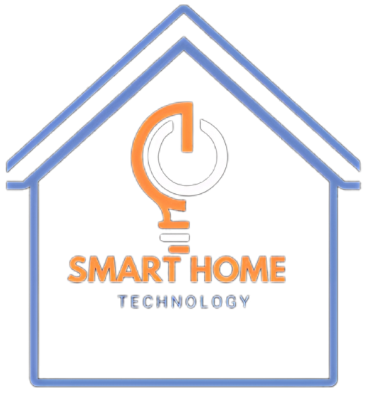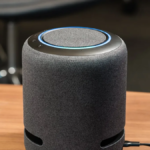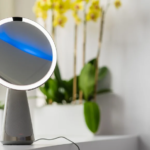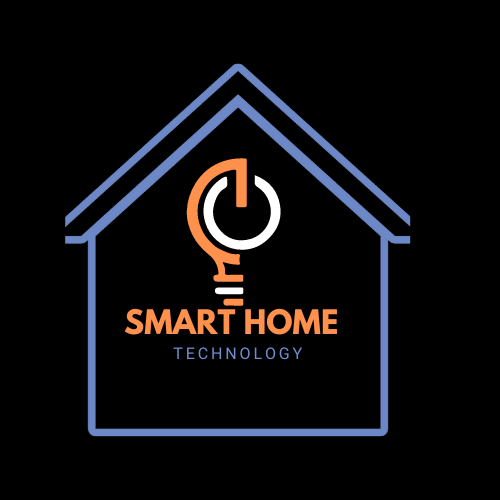

Are you ready to make your house a flawless, tech-enabled paradise? Voice-activated technologies driven by smart assistants will transform our interactions with our homes in 2025 by fusing convenience, security, and entertainment.
Imagine using a basic voice command to control your thermostat, change the lighting, or lock your house. This article will dissect the top voice-activated smart assistants and systems of 2025 regardless of your level of smart home interest or just starting your path.
We’ll investigate:
Top Features: What distinguishes every smart assistant?
Which system fits your present hardware the best?
Affordability: Choices to fit many budgets without sacrificing quality.
Table of Contents
Smart home systems now serve more purposes than convenience—they are almost a way of life! I felt like I was living in the future when I instructed my virtual assistant to turn down the lights for the first time. The options might become daunting as voice-activated smart home devices become more innovative and user-friendly.
Whether you’re new to home automation or seeking to update your setup, 2025 offers a selection of innovative systems that fit every need, from efficiently managing your entertainment to tracking your energy use. This review will walk you through the year’s best voice-activated smart home systems, compare them, and highlight what makes them worthwhile. Let us start right now!
What Makes a Great Voice-Controlled Smart Home System?
Selecting a voice-activated smart home system may overwhelm one with the choices. Though not all systems are equal, many bright devices with interesting capabilities are available. I have discovered over time that the finest systems have a few fundamental traits that distinguish them. This is what to search for regardless of your level of experience as a techie or absolute novice:
Compatibility: A Smart System Should Play Well With Others
Setting up my bright house has taught me, among other things, that compatibility is crucial. Once, I purchased a stunning smart thermostat, but it was incompatible with my current smart hub—a significant error. This meant juggling many applications to operate my devices, which was annoying.
The most significant systems are made to run perfectly with many different brands and devices. You want everything under one virtual roof, whether you are managing your lights, locks, cameras, or your coffee maker. Search for systems supporting common standards such as Matter, Z-Wave, or Zigbee. Regardless of brand, these systems guarantee that your gadgets can “talk” to one another.
Ease of Use: Keep It Simple, Silly
A smart home system should simplify rather than complicate life. For this reason, simplicity of usage is essential. I can’t count the times I have spent debugging a system that was too difficult to set up or operate. The good news is that most top-notch systems now have simple voice commands and easy applications.
For instance, Google Assistant and Alexa shine here. Just say, “Alexa, turn off the lights,” and blast. Apps help you avoid learning complex instructions by memory or fumbling. Easy-to-use interfaces and setup procedures guarantee that even the least tech-savvy people can profit from home automation.
Privacy: You cannot negotiate to protect your data.
Let us consider privacy the elephant in the room. I know to ignore this aspect when you’re thrilled about new devices. You don’t want to disregard it, though, believe me. Your smart home system will gather much information about your behaviour, so you must ensure its security.
Apple’s HomeKit, for example, is renowned for its strong advocacy for privacy. End-to-end encryption means Apple cannot even access your data. Other sites like Google and Amazon also have privacy settings, but you must investigate their choices to fit you. Always review the tiny print to be sure your information is safeguarded. Pro tip: Steer clear of systems from unknown manufacturers with dubious privacy policies—that risk is not worth it.
Integration With Popular Platforms (Alexa, Google Assistant, Siri)
This one’s a game-changer. A solid, smart home system should fit very well with your preferred voice assistant. Whether your preferred platform is Siri, Google Assistant, or Alexa, having your system operate with one of these platforms guarantees seamless operation.
Every platform has some advantages. While Google Assistant boasts unparalleled AI smarts for answering inquiries, Alexa is renowned for its connectivity with many devices. Siri is ideal for Apple aficionados seeking a close connection with their iPads, iPhones, and Apple Watches. Keep your current use; it will save you time and trouble.
Compatibility of Smart Devices and Ecosystem Development
A smart home system is not a one-time purchase. It’s a purchase into a developing environment. As you assess systems, consider the long term. Would this system allow you to add more devices later on? Can you adjust your configuration as your demands evolve?
For example, I began with only a smart speaker, but within months, I added a thermostat, bright lighting, and a video doorbell. An OnA system must allow growth without sacrificing budgets or generating compatibility problems.
Customizable Choices and User-Friendly Apps
Not least of all, let us discuss applications. The app must be responsive and easy to use, as it functions almost as the command centre for your bright house. Some systems, such as SmartThings and Home Assistant, have excellent customizing options that help you create thoroughly automated routines. Would you like your playlist to start when you enter the door and your lights fade? With the appropriate software, it’s entirely possible.
Look for features like:
Custom routines (like “Good Night” mode that locks doors and turns off lights)
Remote control will let you run your house from anywhere.
Usage insights (monitor energy use to cut costs)
When selecting a voice-activated smart home system, prioritize your priorities. Perhaps you value privacy or want a simple system extension. Simultaneously, prioritize compatibility, simplicity, and a great connection with your preferred voice assistant. Remember that your smart home should simplify rather than complicate your life. Choose carefully; soon, you will enjoy your most excellent futuristic life!
Top Voice-Controlled Smart Home Systems for 2025


There is intense competition among the top voice-activated smart home systems expected for 2025. After plenty of testing and tinkering, let me tell you specific systems shine more than others. Here are my best choices whether your search is for a cheap setup or a strong ecosystem:
Amazon Echo Smart Home Hub (5th Gen)
This is true if you’re all in on Alexa. The fifth-generation Echo Hub effortlessly links with more devices than ever, including lights, thermostats, and security cameras. Moreover, the enhanced voice recognition technology makes Alexa seem to understand you better than she used to.
Google Nest Hub Max (2nd Gen)
The Google Assistant’s capacity to answer almost anything practically—serially, it’s like talking with a tech-savvy friend—has always delighted me. The new Nest Hub Max advances that by combining voice control with a bright touchscreen ideal for multitasking between streaming films and device management.
Apple HomePod Mini (2025 Update)
Apple’s revised HomePod Mini still sets the benchmark if your priority is privacy. Siri works wonderfully with Apple products and, owing to thanked triggers, allows you to manage your smart home with just a few words—or simply a glaSamsung SmartThings Hub V4.
Samsung’s SmartThings Hub is the best approach for ultimate personalization. The freedom is unparalleled. I programmed mine to handle everything from morning alarms to sleep rituals automatically.
Wyze Smart Home Ecosystematic
Budget-wise, Wyze offers reasonably priced gadgets without compromising quality. Their cameras and smart plugs brilliantly integrate into a simple, voice-activated system.
Here’s a quick tip: Whatever system you choose, ensure it integrates with your existing devices. Trust me; discovering that your preferred innovative bulb brand does not play well with your bright new hub is nothing worse.
Smart home technologies run under voice control and are developing quicker than ever. 2025 offers some fantastic choices. Whether you’re team Alexa, Siri, or Google smart Assistant or investigating alternatives like SmartThings, a solution out there will simplify, maximize, and make your life more enjoyable.
What is your following action? Explore the systems that interest you, learn from user feedback, and sketch your perfect configuration. Home automation’s future is here; now is the time to make it yours.
How to Choose the Right System for Your Home


The ideal voice-activated smart home solution is not one-size-fits-all. Trust me; I have more than once gone through the trial-and-error stage. Here’s how to decide wisely without squandering money or time:
Evaluate Your Requirements
Before entering the smart home frenzy, ask yourself what main objective you have in mind. Are you running your lights automatically? Strengthening security Perhaps you wish for a completely integrated system capable of doing everything. Although I needed everything when I first started, the best approach to get started is to concentrate on your immediate requirements.
Know Your Ecosystemution
Do you team up with people from Google or Amazon? Your present tools will influence your choice. Apple’s HomeKit may be your best friend if you own an iPhone. Staying with Amazon makes sense if you already have an Alexa gadget on your kitchen counter. Although it is feasible to mix ecosystems, improper device syncing might cause issues.
Think Through Your Budget
Many find themselves caught in this area. Friends have shown me spending hundreds on an elegant system they hardly use. From low-cost choices like Wyze to upscale configurations like Control4, smart home systems span budgets. Clearly define your budget; remember that you may always grow later.
Search for Harmony
Selecting a system that supports Matter or another universal protocol helps future-proof your configuration. You do not want to be left with gadgets that won’t interact when new standards develop. Trust me; I have visited; it is a nightmare.
| Feature | Amazon Alexa | Google Assistant | Apple Siri | Microsoft Cortana |
|---|---|---|---|---|
| Compatibility | Works with Amazon Echo devices & others | Works with Google Nest & other devices | Works with Apple devices (iPhone, iPad) | Primarily for Windows devices, Xbox |
| Voice Recognition | Supports multiple languages | Supports multiple languages | Limited languages, best with Apple products | Limited, primarily English |
| Smart Home Integration | Extensive support for smart home devices | Works with Google smart home products | Works with HomeKit-enabled devices | Limited integration with smart home devices |
| Streaming Services | Amazon Music, Spotify, Apple Music, etc. | Google Music, YouTube Music, Spotify | Apple Music, Spotify | Limited support for streaming services |
| Daily Tasks | Calendar, weather, shopping, reminders | Calendar, weather, shopping, reminders | Calendar, weather, reminders | Calendar, reminders, emails |
| Skills & Actions | Thousands of skills available | Customizable actions available | Limited third-party integration | Limited third-party actions |
| Privacy & Security | Customizable privacy settings | Google Assistant offers privacy features | Apple’s focus on privacy, limited data sharing | Focused on user data privacy |
| Ideal For | Smart home control, shopping, entertainment | Integration with Google services and Android devices | Apple ecosystem, privacy-focused users | Microsoft ecosystem users, productivity |
| Supported Devices | Echo, Echo Dot, Echo Show, Fire TV | Nest Hub, Google Home, Android phones | iPhone, iPad, HomePod, Apple Watch | Windows PCs, Xbox, select smart speakers |
| Best For | Beginners seeking an easy smart home setup | Android users or those using Google services | Apple fans who prioritize privacy | Users in the Microsoft ecosystem |
This table highlights the most relevant features and differences between the leading voice-controlled smart assistants to help beginners choose the best one for their needs in 2025.
Tips for Setting Up Your Voice-Controlled Smart Home System
Establishing a smart home system might seem like building IKEA furniture—doable but sometimes horrifying. Here are some pointers to help the process go more smoothly based on my own—sometimes annoying—experiences:
- Detailed instructions for installation
- Steering clear of typical configuration errors
- Maximizing your system for the best operation
Start Small
On day one, avoid trying to run your house automatically. Instead, start with one or two primary devices, such as a smart speaker and bright lamps. Starting with only two lights and a Google Nest Mini, it was the ideal approach to ease into things without feeling overburdened.
Use the guidelines.
This seems straightforward, but I have learned that omitting manual processes can make connecting your hub to your Wi-Fi network challenging. Follow the setup directions closely when doing so.
Design Routines and Groups.
Sort your equipment according to room or use it to simplify voice instructions. For instance, I arranged all of my living room lights so that I could say, “Turn off the living room lights,” rather than individually regulating them. Once you have perfect grouping, try routines like “Good Night” or “Movie Time.”
Place your devices deliberately in line.
The location of your smart speaker or hub might affect its performance. Avoid placing it in dead areas with poor Wi-Fi or near loud equipment. I once put my Alexa speaker near the TV, and it kept misreading orders.
Restrain Your Network
This one is big. Smart home gadgets can be hacked easily, so ensure your Wi-Fi network is safe. Whenever feasible, activate two-factor authentication and choose a strong password.
Voice-Controlled Smart Homes: Future Prospect
Smart homes under voice control are getting more innovative, customized, and ingrained into our lives—they are not only about convenience anymore. The future promises:
Imagine entering your house, and your smart home recognizes what you need. AI is headed in that direction. Alexa and Google Assistant are among the systems that improve their understanding of your preferences and behaviour. My Google smart Assistant has suggested practices I never would have considered, including turning on my coffee maker first thing in the morning.
Perfect Integration Over Multiple Devices
Smart houses have a far less scattered future as universal protocols like Matter become more common. Finally, we are headed towards a time when products from several manufacturers interact effortlessly. You should stop worrying about whether your smart thermostat will connect with your smart hub; it will just.
Improved Protection of Privacy and Security
As smart homes become more powerful, privacy concerns become more sophisticated. Companies are emphasizing data encryption and giving consumers more control over the data they gather. Apple, for example, is already driving this trend, and other businesses are catching on.
Energy sustainability and efficiency
Smart houses also enable us to live more ecologically friendly lives. From smart thermostats that maximize energy use to systems tracking and lowering water consumption, sustainability is taking center stage. Thanks to the smart assistant automation, my energy bill has already dropped, and this trend will become more pronounced.
Beyond the Home: Smart Communities
Although this seems like science fiction, innovative technology is beginning to be used in specific communities. From shared energy systems to linked streetlights, the future is about smart communities, not just smart houses.
Conclusion
Voice-activated smart home devices are no longer a luxury for anyone trying to improve their living experience; they are a game-changer. Selecting the correct system and optimizing its configuration will help you build a house that perfectly fits your requirements. 2025’s portfolio has something for everyone, whether your preferred platform is Alexa, Google Assistant, or another.
Start your journey towards better living right now! Which system would be the most thrilling for you to use? Tell us or get in touch to get further insights.
FAQs
What’s the most affordable voice-controlled smart home system in 2025?
Without sacrificing quality, Wyze presents some of the greatest reasonably priced choices.
Can I use multiple systems together?
Indeed, device compatibility will determine this. Some hubs, like SmartThings, are meant to function across ecosystems.
How secure are voice-controlled smart home systems?
Brands affect security. Apple and Google prioritize privacy, and third-party integrations may need even more care.
What happens if the internet goes down?
While most devices offer offline capability for simple activities, functionalities like speech recognition might be restricted.
Are smart home systems worth the investment?
They pay off financially and psychologically if you like home security, energy economy, and ease.




Pingback: How to Set Up a Voice-Controlled Smart Home in 5 Simple Steps (2025 Guide) - smarthomze.com
Pingback: Smart Homes Made Simple: The Best Voice-Controlled Systems of 2025 - smarthomze.com
Pingback: 10 Lesser-Known Features of Amazon Alexa You Should Know in 2025 - smarthomze.com
Pingback: Voice-Controlled Smart Assistants for Beginners: The Ultimate Guide 2025" - smarthomze.com
Pingback: How to Troubleshoot Common Issues with Voice-Controlled Devices (2025 Guide) - smarthomze.com
Pingback: Voice Commands Every Google Home Owner Should Master in 2025 - smarthomze.com
Pingback: Voice-Controlled Smart Assistants for Seniors: A Complete Guide (2025) - smarthomze.com
Pingback: The Environmental Impact of Using Smart Assistants at Home: Are They Green? (2025) - smarthomze.com
Pingback: Voice-Controlled Devices for Home Automation: A Beginner’s Guide (2025 Edition) - smarthomze.com
Pingback: How to Pair Smart Speakers with Multiple Smart Devices (2025 Guide) - smarthomze.com
Pingback: Top Voice-Controlled Devices for Home Security in 2025 [Expert Picks] - smarthomze.com